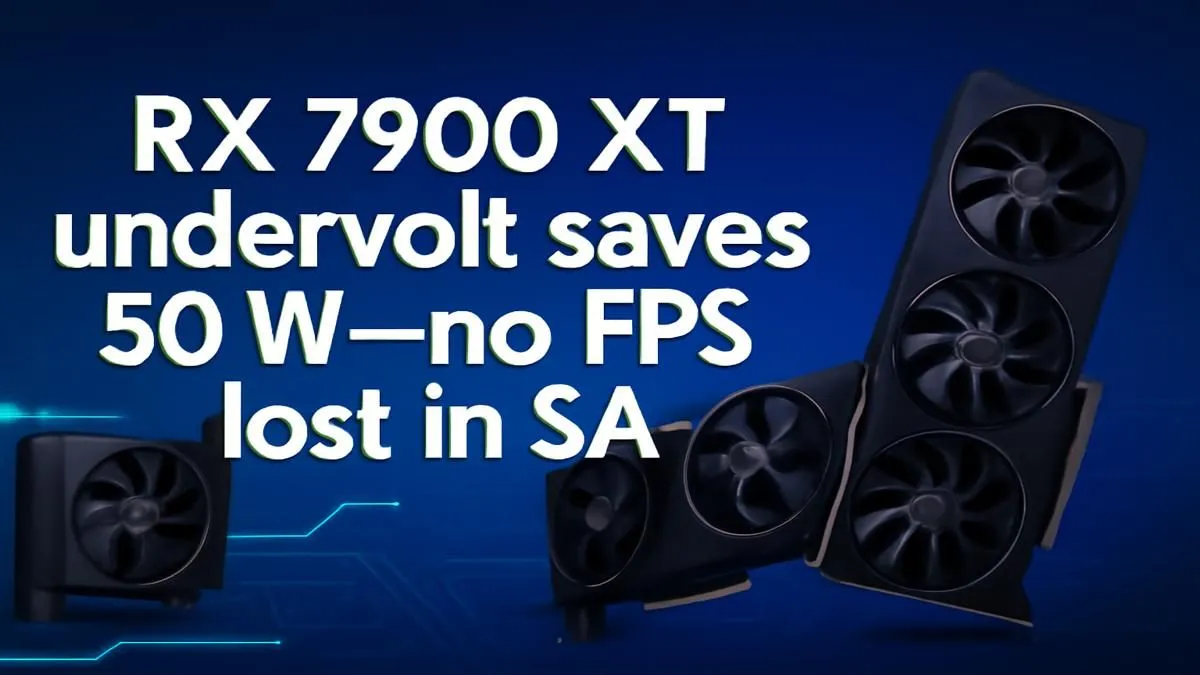
What Are Chair Caster Locks?
Chair caster locks prevent rolling rage quit. Secure your office chair in place for maximum stability and focus. 🪑🚫
Unlock massive power savings 🌟 with our RX 7900 XT undervolt guide. Achieve up to 50W reduction with zero FPS loss in Shadow Arena ⚡️ Boost performance and efficiency today!

So, you've got your hands on a beastly AMD Radeon RX 7900 XT. It's tearing through the latest titles, but you can hear the fans spinning up and feel the heat... not to mention the quiet hum it adds to your electricity bill. What if you could cool it down, save power, and lose absolutely zero performance? ⚡
Welcome to the ultimate RX 7900 XT undervolt guide for South African gamers. This is a free, simple tweak that unlocks hidden efficiency.
Think of undervolting as optimising your card's fuel intake. Graphics cards often ship from the factory with a slightly higher voltage than necessary to guarantee stability across millions of units. By manually tuning it, you're finding the perfect, lower voltage for your specific card.
The benefits are real, especially in the South African climate:
While this guide focuses on the 7900 XT, the principles of tweaking apply across the board, whether you're running the latest from the red team or checking out what Nvidia GeForce GTX graphics cards have to offer.






Ready to get started? All you need is AMD's own Adrenalin software—no sketchy third-party downloads required. This process is safe and reversible.
Right-click on your desktop and open the AMD software. Navigate to the Performance tab at the top, and then click on the Tuning sub-tab.
In the Tuning section, you'll see "Tuning Control". Switch it from 'Automatic' to Custom and agree to the warning. This unlocks the manual controls we need. Now, enable GPU Tuning to reveal the advanced options.
Before you change anything, run a benchmark like 3DMark Time Spy or the built-in test in a game you play often. Note your score, peak temperature, and average FPS. This gives you a baseline to compare your results against.
Enable Advanced Control. The main setting we care about is Voltage (mV). Don't touch the Max Frequency (MHz) just yet. The stock voltage is typically around 1150mV.
Start by lowering the voltage by a small amount, say 25mV, so it reads 1125mV. Click Apply Changes in the top right.
Now for the crucial part. Run the same benchmark or game you used for your baseline test. Let it run for at least 15-20 minutes. If your system doesn't crash and you see no weird visual glitches (artefacts), you're stable!
If it's stable, go back to Step 3 and lower the voltage by another 15-25mV. Rinse and repeat.
Eventually, you'll find a voltage that is unstable—your game will crash or your PC will restart. When that happens, simply go back to the last stable voltage setting you had. That's your card's sweet spot. This entire process is a core part of getting the most from the powerful RDNA 3 architecture found in all modern AMD Radeon graphics cards.
The "silicon lottery" means every card is slightly different, but the results are consistently impressive. On our test bench, we achieved a stable undervolt at 1075mV.
The outcome? Peak power draw in Helldivers 2 dropped from ~310W to ~260W. That's a 50-watt saving. Temperatures fell by 6°C, and our frame rate... was identical. Zero performance loss. Whether you're building an AMD, Nvidia, or even one of the new Intel ARC gaming PCs, optimising for efficiency is a smart move.
This simple RX 7900 XT tuning makes your high-end card sip power instead of gulping it, all without sacrificing the performance you paid for. It’s one of the best free upgrades you can perform, no matter which brand of graphics cards you prefer.
Ready for a Performance Upgrade? Whether you're optimising your current rig or building a new one, getting the best performance for your Rand is what matters. Check out the best graphics card deals in South Africa for an upgrade that delivers pure power.
By reducing voltage, the GPU consumes less energy while maintaining clock speeds and performance globally.
No, with precise tuning, there is zero FPS loss while achieving significant power savings.
Use software like AMD Adrenalin Edition or third-party tools (e.g., EVGA Precision X1) to safely adjust voltages.
Yes. Proper undervolting reduces heat and stress, extending GPU lifecycle without performance compromises.
Power profiles let users balance performance and efficiency, making undervolting more effective in game scenarios.
Yes, reduced voltage typically lowers the GPU's temperature output during gaming and idle states.
Start with -100mV offset, adjusting based on stability and FPS consistency under load.
Usually not, as modern tools don’t alter permanent voltage settings, preserving factory warranty.